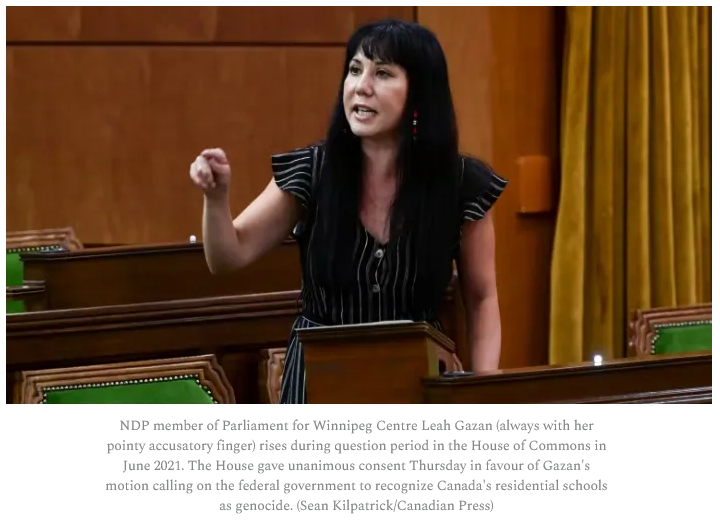Nina Green suggests that Bill C-413’s sponsor might be the first person in Canada to face criminal charges in that piece of legislation if her private member’s bill gets Royal Assent:
On 31 October 2024 Member of Parliament Leah Gazan called a press conference to lobby for Bill C-413, her private member’s bill designed to criminalize her fellow citizens for disagreeing with her views.
Gazan led off the press conference with this statement:
Good morning, everybody. I’m Leah Gazan, and I’m the Member of Parliament from Winnipeg Centre, and we’re here to discuss support of Bill C-413 to amend the Criminal Code to include the willful promotion of hate against Indigenous peoples by condoning, downplaying, justifying the residential schools.
To evoke an emotional response, Gazan used the word “violence” a dozen times during her press conference, falsely equating speech with violence, although violence by definition involves physical force.
Gazan’s bill is obviously not aimed at preventing physical violence against Indigenous people. It is aimed at preventing her fellow Canadians from saying anything positive about Indian residential schools.
Earlier, on 27 September 2024, Gazan made the bill personal, telling CTV News that “my family has been impacted by residential school”, implying that she had been motivated to introduce her bill because of the serious harm residential schools had inflicted on her own family.
In fact, the exact opposite is true. Residential schools had a positive effect on Leah Gazan’s family.
On her father’s side, Gazan is Jewish, and her maternal grandfather was Chinese. Thus her only possible connection to Indian residential schools is through her maternal grandmother, Adeline LeCaine, the daughter of Leah Gazan’s great-grandfather, John LeCaine (1890-1964).
What we learn about John LeCaine turns out to be surprising. He was the son of a white North West Mounted Police officer, William Edward Archibald LeCain (1859-1915), and Emma Loves War, whose Lakota Sioux family sought refuge in Canada with Chief Sitting Bull and 5000 of his people after the massacre of Custer and his men at the Battle of the Little Big Horn. […]
Since he had a white father and an American Indian mother, John LeCaine was, in the terminology of the day, a half-breed, and ineligible to attend a residential school since federally-funded Indian residential schools were reserved for status Indians under the Indian Act. However an exception was made, and both John LeCaine and his sister Alice LeCaine (1888-1976) were admitted to the Regina Industrial School. John LeCaine attended for seven years, from 1899 to 1906 when he was 9 to 16 years of age. While there he learned to read and write English proficiently, and mastered agricultural and carpentry skills which equipped him to apply, like white settlers at the time, for a homestead, which he proved up in 1913. In 1914 he wrote to the Department of the Interior asking for a ruling on whether his two half-brothers — who were full-blooded Sioux — could also apply for homesteads.
The proficiency in English he acquired at the Regina Industrial School enabled John LeCaine to became a writer and a historian of the Lakota people. In later years he mapped the places he and his stepfather, Okute Sica, had visited on a journey to the Frenchman River in 1910, and wrote a collection of stories told to him by Sioux Elders, Reflections of the Sioux World, as well as other articles, including some published in the Oblate journal, The Indian Record.




